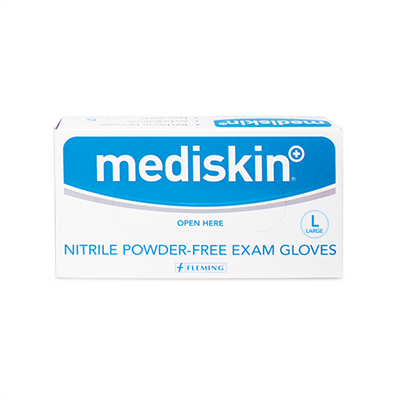Headlines
- Advanced Footcare Solutions: Use Cases Explained
- Keeping Customers Covered: How Pharmacies can address the Summer Burn Surge - A clinical and practical guide for pharmacy teams
- Fleming Medical Achieves ISO 13485 Certification – Reinforcing Our Commitment to Patient Safety and Quality
- Gentle Daily Ear Care with Medicare Ear Spray
- Breathe Easy with Medicare Nasal Spray
Know The Difference - Nitrile vs Latex Gloves
23 March 2023
 Nitrile and latex gloves have two features in common, they are both lightweight and elastic. However,
there are a number of factors and characteristics that set these two types of gloves apart.
Nitrile and latex gloves have two features in common, they are both lightweight and elastic. However,
there are a number of factors and characteristics that set these two types of gloves apart.
While both types of gloves are proven forms of PPE, research has shown that nitrile gloves are the more versatile and reliable solution. Read our 5 key points to discover why Mediskin Powderfree Nitrile Gloves are the best overall choice.

Hypoallergenic
On the other hand, nitrile does not contain proteins that may cause an allergic reaction. This makes them the perfect alternative to latex gloves. Nitrile gloves are the best solution within industries where gloves could come in contact with those that have an allergy to latex. The healthcare and food industries are key examples where proper care and attention to allergies is vitally important.

Puncture Resistant
This is due to nitrile being a thicker material with more durability and flexibility. This makes them a suitable glove for those seeking hand protection against mechanical equipment, or for anyone requiring protection in risky workplaces, especially where sharp objects are used.
In the event that a nitrile glove is punctured or torn, they are design to quickly reveal the tear. This useful feature is enhanced by the flexible qualities of the gloves. Latex gloves do not reveal tiny holes and tears as effectively as nitrile gloves. Punctures that go undetected can have detrimental consequences especially for those that could be exposed to hazardous substances and mechanical equipment.

Chemical Resistant
Furthermore, nitrile gloves are puncture resistant. This offers additional protection as their puncture resistant quality protects hands from hazardous substances and chemicals.

Sense of Touch

Comfortable Fit
With this in mind, nitrile gloves offer their users a comfortable solution that fits properly to your hands. The gloves react with the temperature of your hands which allows them to conform to their size and shape.

Mediskin Powder-Free Nitrile Gloves
Mediskin Blue Nitrile Powder-Free Exam Gloves are a type of disposable glove made of synthetic rubber that offer excellent resistance to wear and tear. The gloves are used while conducting medical examinations, diagnostic and therapeutic procedures to protect from cross contamination or infection.
Product Features
- Latex Free.
- Non Sterile Nitrile (Carboxylated Budadiene Acroylonitrile).
- High abrasion and puncture resistance.
- Micro-textured for better wet and dry grip.
- Rolled cuff.
- Meets requirements of EN455-1:2000, EN455-2:2015, EN455-3:2015, EN455-4:2009.
- CE Certified Class 1 Medical Device.
- Thickness: 3mm.
- Average weight of medium glove: 3g (=-0.2g).
- Available in S,M,L & XL

 Fleming Medical UK
Fleming Medical UK

